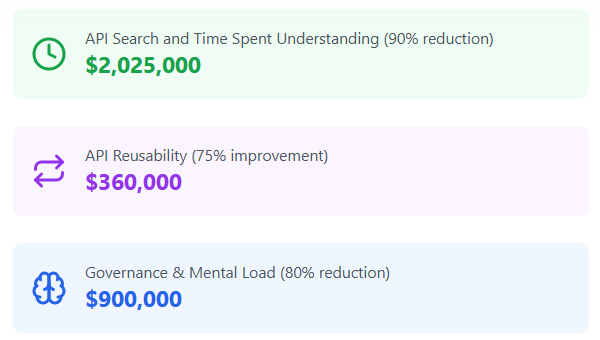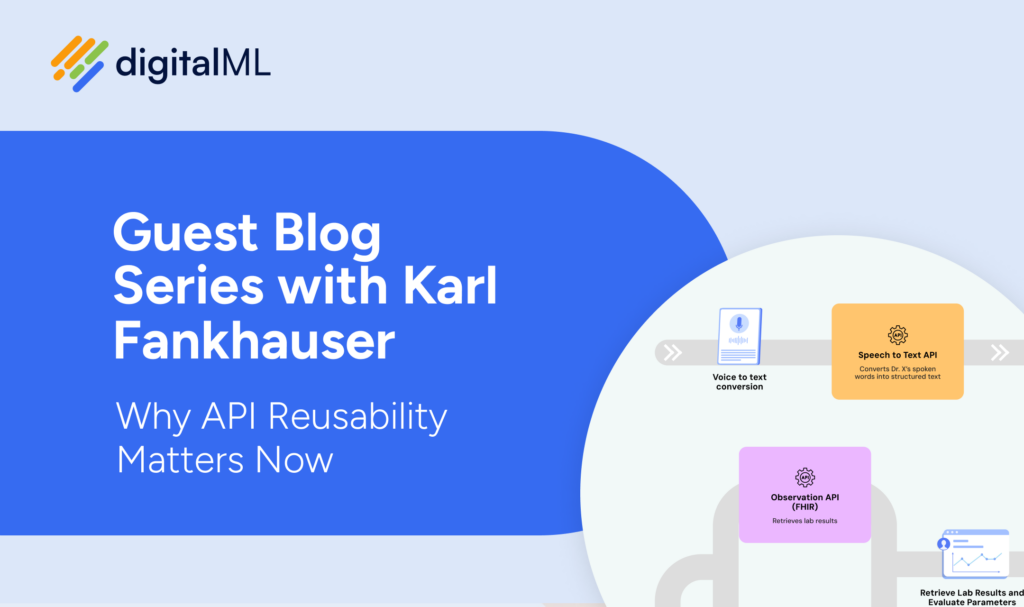What is an API Catalog? Definition and Tactics
Key Takeaways:
An API catalog is a centralized, searchable repository of all the APIs in your ecosystem, containing key metadata and documentation for each API to aid discovery and effective API management. A Holistic API Catalog is the best choice for large enterprises. This is because it provides a unified, abstracted, and active approach to API cataloguing and management.
The growth of application programming interfaces (APIs) in enterprises leads to a need for a single location to capture, manage, govern, and drive value from APIs across all runtimes and lifecycle states. An API catalog is the solution. But not all catalogs are created equally. In this post, we’ll define the API catalog and its core features. We will also talk about why your API catalog should be holistic, abstracted, and connected to your entire API ecosystem.
What is an API catalog? And why you need one
The use of APIs has grown rapidly. This is causing “API sprawl” in many organizations, with different types of APIs running across multiple systems. In fact, the average organization is now interacting with over 15,000 APIs.
API sprawl is a looming threat to the success of your API program. It can lead to duplication, higher security risks, and reduced API adoption and reuse. These are serious concerns, and an API catalog can help.
An API catalog is a centralized, searchable repository of all the APIs in your ecosystem, including internal APIs, partner APIs, and external APIs. It contains key metadata and documentation for each API to aid discovery and effective API management. It should also be capturing the your organization’s entire scope of APIs, such as legacy SOAP services, RESTful APIs, Async APIs, GraphQL, etc.
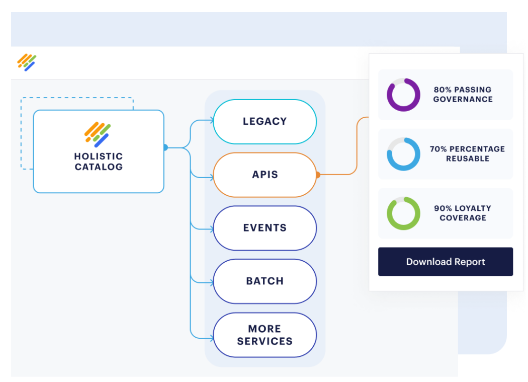
The API catalog is used by a wide range of roles in your API ecosystem. These include provider and consumer developers, governance and compliance teams, business stakeholders, and of course your core API platform team.
Benefits of a good API Catalog
That’s where an API catalog comes in. Properly cataloging your APIs into a single location can:
- Create a single source of truth for all APIs across the enterprise.
- Ensure you can successfully reduce duplication and redundancy while driving API reuse.
- Improve API discovery and reuse as you can effectively feed curated content to your consumers.
- Provide a view into the makeup of your API inventory; helping you understand how compliant and well-governed it is, as well as who owns each API and where they are running.
- Reduce security vulnerabilities by identifying and tackling threats such as zombie and shadow APIs.
- Help effectively manage the lifecycle of your APIs including lifecycle implications of multiple consumers adopting your APIs.
- Assist prioritization of business goals for your API program.
Comparing the API catalog to the API portal
While a catalog is the location for all your APIs, the API portal (sometimes known as a developer portal or consumer portal) is different. This is the consumption interface for your best APIs you want to be adopted or reused. We recently compared the API catalog and portal (as well as the developer marketplace) in full.
Key features of an API catalog
The best API catalogs offer functionality including:
- Centralized repository: A single view of every API in the enterprise.
- API reporting: Unified metrics across design, run, and consumption to effectively understand the inventory.
- API organization: A way to categorize APIs e.g. according to business capability models.
- Search and discovery: Powerful search capabilities to quickly find relevant APIs.
- Comprehensive documentation and API metadata: Detailed information on API endpoints, methods, parameters, and responses as well as lifecycle state, ownership, and more.
- API governance and security: To ensure APIs are complete, consistent, and compliant with your enterprise’s standards and security strategy.
- Versioning: Track changes and updates to APIs over time.
- An easy way to promote APIs to the API portal: Driving effective API consumption and reuse while managing the lifecycle implications of doing so.
- Integrations to the rest of your IT landscape: The catalog needs to be connected and active to ensure it’s always up to date and is driving user adoption.
Why your API catalog should be holistic and abstracted
Many often think of the catalog as a component of an API gateway or runtime API management tool. While tooling in this area has evolved well, with many API management vendors now able to catalog APIs across heterogenous gateways, this approach still faces two major roadblocks in being able to deliver a catalog’s promised benefits.
You need to catalog all APIs in all lifecycle states
Firstly, runtime based API catalogs are only capturing those APIs already in production.
In reality, especially within large enterprises, there are many APIs out there in different lifecycle states that need to be captured and managed too. Examples include new API versions that have been checked into GitHub by your developers but need to be approved by your API governance team, or new APIs you’re creating in a top-down process that are still in the design stages.
You need a holistic and active view of everything that’s present across your API ecosystem. Capturing all this as well as every APIs across multiple runtimes such as API gateways, Event engines, Enterprise Service Buses (ESBs) and more is essential for an accurate view of your API portfolio.
Your API portfolio needs to be flexible and portable
The second issue is that these types of catalogs store APIs in their implementation specific code.
Enterprises are increasingly needing flexibility and portability in their APIs to introduce runtime cost savings and operational efficiencies. This is especially true if you’re adopting a hybrid and multi cloud approach.
Runtime API catalogs prevent this flexibility and make it slow and resource heavy to refactor and redeploy APIs across environments as they need to be recoded each time.
That’s why we recommend you look for an API catalog solution that’s upstream of (but connected to) your repos, pipelines, and gateways, and abstracts your APIs away from their implementation code to provide you a holistic view with built in flexibility.
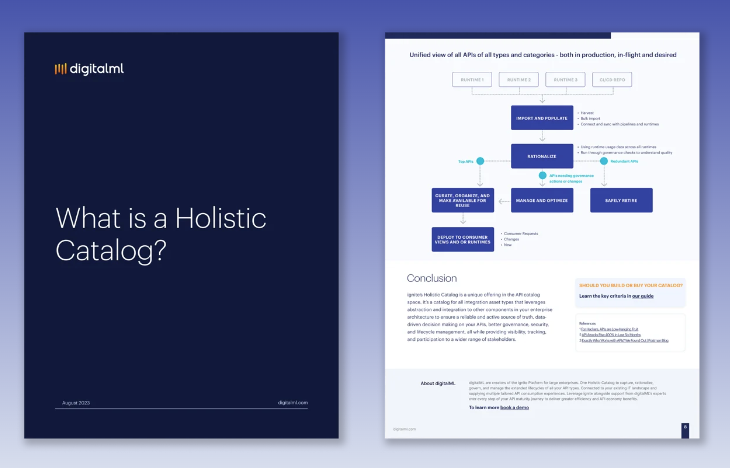
Frequently Asked Questions (FAQ) About Cataloging APIs
1. How is an API catalog different from an API gateway?
An API gateway manages API traffic, authentication, and request routing, while an API catalog provides visibility and governance across all APIs, regardless of where they are deployed.
2. Can I build my own API catalog?
Yes, but building an API catalog in-house requires ongoing maintenance, integration with multiple platforms, and governance automation. A dedicated solution like ignite simplifies cataloging by providing pre-built synchronization, governance controls, and reporting tools.
Many enterprises debate whether they should adopt a specific catalog tool, or try and create an API catalog either in house or using open source offerings. We discuss the considerations in detail in our build vs buy paper which you can download below. But at a high level, our enterprise customers have found that by buying a catalog tool like ignite’s Holistic Catalog, they can focus on delivering value from their APIs themselves from the outset, rather than having to invest time and money in building and maintaining the functionality that helps them do this.
3. How does an API catalog improve API security?
An API catalog helps with API security in these ways:
- Identify shadow APIs that could pose security risks.
- Track API versions to prevent outdated or insecure deployments.
- Monitor compliance adherence with regulatory requirements.
- Detect duplicate or redundant APIs that increase attack surfaces.
4. How do I ensure my API catalog stays up to date?
To maintain an accurate API catalog, you should:
- Automate syncs with API repositories (GitHub, GitLab, etc.)
- Integrate with API gateways for runtime insights
- Use governance workflows to flag security risks and outdated APIs
- Regularly audit the inventory to remove deprecated APIs
5. What are the best tools for API cataloging?
The best API cataloging tools include:
- digitalML’s ignite Platform – A dedicated enterprise API catalog for governance and reuse, alongside Consumer Portals and Extended API Lifecycle Management support
- SwaggerHub – Focused on OpenAPI documentation
- Backstage (by Spotify) – An open-source developer portal with API cataloging capabilities
- APIM platforms (Apigee, Kong, etc.) – Some include basic cataloging features
7. How does an API catalog improve API reuse?
By making APIs searchable and categorized, an API catalog prevents teams from reinventing the wheel. Developers can easily find existing APIs that match their needs, speeding up innovation and reducing redundant API creation. This is especially topical at a time where API reusability is more important than ever.
ignite’s Holistic Catalog
Our ignite Platform offers a unique solution to cataloging APIs. ignite provides a Holistic Catalog to capture, manage, govern, analyze, and maximize value from all your APIs across all runtimes and lifecycle states. You can use your catalog to power multiple API Consumer Portals and views to drive increased API adoption and reuse. And ignite keeps the process alive with Extended API Lifecycle Management, too.
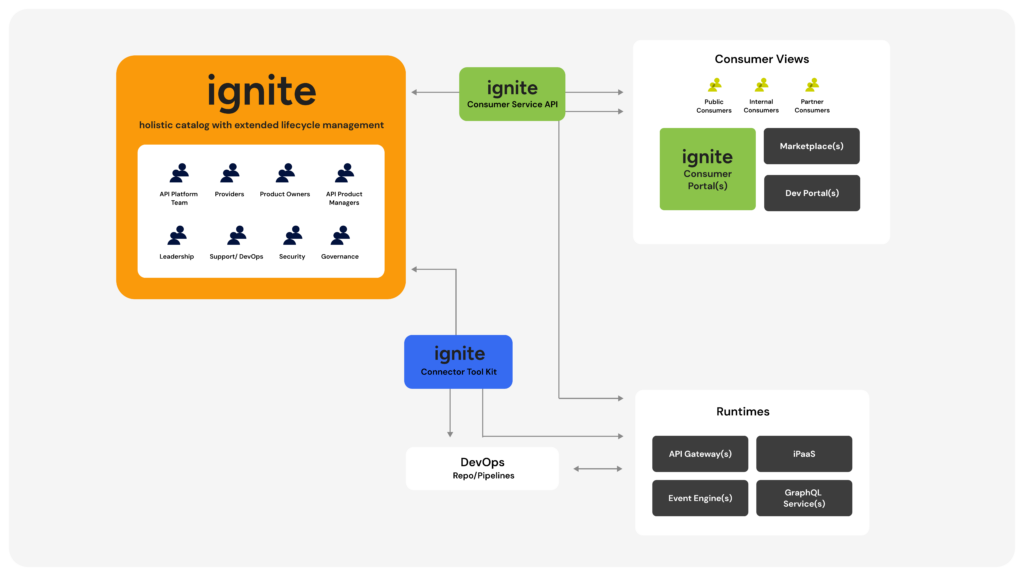
Here are just a few reasons why ignite’s API catalog solution is unique:
- Holistic: Capture every API into your catalog including OAS, WSDLs Async and GraphQL. Either by importing or harvesting from your source code management (SCM) repos and API gateways and runtimes including Apigee X and Edge, Oracle OCI Gateway, AWS, and Microsoft Azure.
- Abstracted: ignite sits upstream of repos, pipelines, and gateways and is totally vendor and platform agnostic. Utilize a unique abstraction technology to manage your APIs as abstracted Designs and Specifications, introducing flexibility across your entire API portfolio
- Connected and active: Your API catalog will only be adopted if it’s up to date and reliable. Connect ignite to your entire API ecosystem including repos, gateways, ticketing and workflow platforms like ServiceNow, reporting aggregators like Splunk, and more.

Conclusion
An API catalog is a critical architectural component for enterprises with large API inventories looking to capture, manage, govern, and drive value from their APIs. A holistic and abstracted approach helps overcome the common challenges of cataloguing APIs at scale, providing a unified and active view, and flexibility and responsiveness.
Differentiate Your Digital Enterprise Now
Learn how it can help your enterprise accelerate digital transformation


